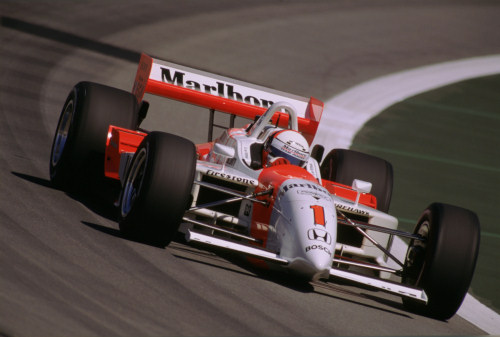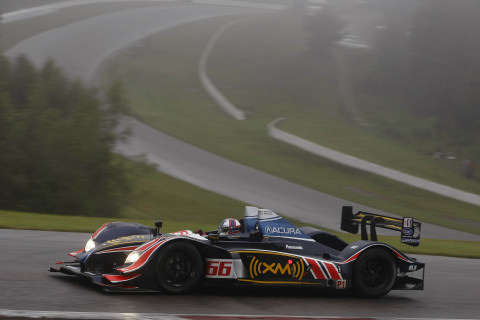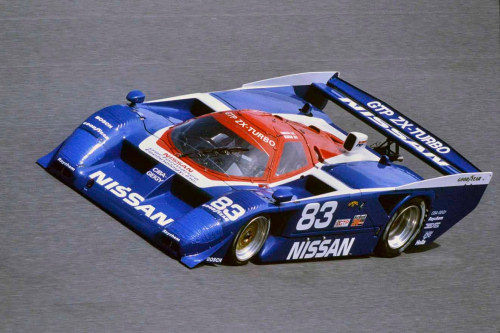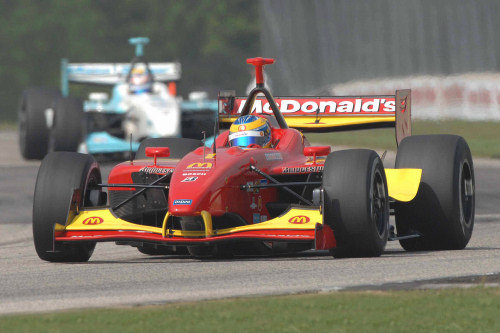The Way It Is/ Sullivan, de Ferran, Geoff Brabham & Bourdais on their favorite carsby Gordon Kirby |
 This week we feature the favorite cars of Danny Sullivan, Gil de Ferran, Geoff Brabham and Sebastien Bourdais. Sullivan and de Ferran won CART championships, Brabham won a brace of IMSA titles and Bourdais was a four-time Champ Car champion. We begin this week's survey with 1985 Indy 500 winner and 1988 CART champion Danny Sullivan.
This week we feature the favorite cars of Danny Sullivan, Gil de Ferran, Geoff Brabham and Sebastien Bourdais. Sullivan and de Ferran won CART championships, Brabham won a brace of IMSA titles and Bourdais was a four-time Champ Car champion. We begin this week's survey with 1985 Indy 500 winner and 1988 CART champion Danny Sullivan.
"I'm blessed that I'm not a guy who raced in only one category," Danny grins. "I got to drive so many different categories of cars and I have some favorite cars across a number of categories. "The GT1 Dauer Porsche 962 that I raced at Le Mans in 1994 was a fabulous car. It was a really easy car to drive and did everything right. It was basically a 962 with low drag bodywork. I only drove the 962 at Le Mans and it was just a treat to drive. You didn't have to over-drive or over-brake it. It did everything really nicely. "I drove with Hans Stuck and Thierry Boutsen that year and we finished third. I remember I came in after my stint through the end of the night into the dawn and when I got out of the car the mechanics were quietly clapping. I didn't know what was going so I asked them and they told me every lap I did was quicker than the pole.  © Racemaker/Dennis Torres "Probably the best Indy car I drove was the Penske PC17 that I won the championship with in 1988. I won four races and took nine poles with that car and Rick (Mears) also won some races, including the Indy 500. That car was good on all types of racetracks. It was capable of winning anywhere and was also a pleasure to drive. "I won the Michigan 500 with that car and I should have won Indy that year but the wing mount broke. I should have won the Pocono 500 as well but I crashed after Dick Simon and Mario had a big crash right in front of me. "One of the most fun cars I ever drove was the Can-Am Frissbee from 1981. That was just a great car. It handled so well and it was so simple. The designer Trevor Harris took a Lola F5000 car and put a low drag body on it that made some downforce. It didn't have an underbody or underwing but it was a ground effects car even though people didn't understand it at the time. "All those cars were a pleasure to drive and when you showed up to drive you knew you were going to be very competitive. Those cars were quick on any type of racetrack. "The Tyrrell F1 car I drove in 1983 was also a great car. It was very easy to drive but it wasn't as quick as the Williams or McLaren. There were a lot of cars that were easy to drive but they weren't fast, but the Tyrrell was fast as well as being easy to drive. But like I say, it wasn't as quick as the Williams or McLaren." Gil de Ferran won back-to-back CART championships with Team Penske's Reynard-Hondas in 2000 and 2001. He also set a world closed course speed record at 241.428 mph in qualifying for the California 500 in 2000.  © Racemaker/Paul Webb "That's one car I was always particularly fond of even though I didn't really like the grooved tires. That was the only time in my life I drove a racing car on cross-ply tires and it was a fun experience because you were always drifting a little bit. "I thought the Reynard was that much better than the '88 Van Diemen I drove the year before. I never liked driving cars with a lot of understeer and the Reynard was just beautifully balanced. It was just very nice to drive, particularly at places like Brands Hatch. "The second car I was very fond of was the Reynard '92 Formula 3 car I won the championship with in 1992. Some people think Formula 3 is underpowered and has too much grip, but I never felt that way. That car didn't have a lot of power but it was such a light and nimble car with a lot of downforce and you could drive it so hard into the corners, which I think lent itself to my driving style. It was a car that didn't have a lot of understeer and it was perfectly balanced and full of grip. "That car fit me like a glove. I felt like the car was an extension of my arms. It was a really nice car to drive. It didn't have a lot of power but you could just play with it and chuck it around and do all sorts of interesting things with it. I always remember that car very fondly. It was also an easy car to set up. We found a good setup early in the season and really didn't change it that much. "Moving into my Indy car era we're talking more about the combination of engine, car and tires, and I have to say the Honda CART engines were just awesome in every respect. I was deeply involved in the development of Honda's engines in those days and I loved every second of it. The engine was so good. It was smooth, very elastic, high-revving with great power delivery and we worked very hard on that. Having all that power and performance and drivability made the car more fun to drive. "The first Indy car I drove was a '95 Reynard-Honda for Jim Hall and I thought it was a perfect car. That was the car I won my first Indy car race with at Laguna Seca in '95. Literally from the first time I sat in it I always felt great about that car. It was a lovely combination of an enormous amount of horsepower with good balance. "One thing I loved about the Indy cars versus the Formula One cars that I drove, and even the F3000 cars, was I could fit properly in the Indy car. It's a really important thing that has a great influence on your perception and feel for the car and the '95 car was my first experience with that level of comfort and performance. I could drive that car comfortably, which was a huge thing for me.  © LAT/USA "It was a great car in every respect. It looked beautiful and was superbly finished, like all Penske cars. It was a Reynard built by Penske with the Penske level of quality, fit and finish. That car looked nice standing still. It made me proud to drive it. I was very proud to drive for Penske and Honda, but that was the epitome of it all. "On road courses it was a great combination of a really well-balanced car with a very smooth engine and very consistent Firestone tires. It was a fantastic combination and something I really enjoyed. We won the championship with that car in 2000 and 2001 and set a world record in qualifying for the California 500 at over 241 mph. "I retired a few years later and was out of driving for several years. Then I came back to run my own team and drive the Acura LMP2 and P1 sports cars in the ALMS. Both the P2 and P1 cars were absolutely fantastic. The P2 was a well sorted car. It was very nice right from the word go, and of course, the P1 car really was a revolutionary machine. It was the first car with the big front tires that all the P1 cars now have. "At the beginning of its life it wasn't a particularly good car because we made a few mistakes with such a revolutionary car. But quickly we figured out what those mistakes were and the car was fantastic. They did an amazing job with that car. I really enjoyed driving that car. It had tons of downforce and the Michelins were really nice tyres to drive. You could brake so late with that car, it was incredible. It's another car that really stays in my mind. Really, it was a Formula One car with a body on it." Geoff Brabham won 26 races and four IMSA GTP championships in a row between 1988-'91 driving Electramotive's Nissan GTP cars. "My favorite race car was the 1988 Nissan GTP car that we won eight races in a row with and the first of four straight IMSA championships," Geoff grins. "We won close to 20 races over the two years we raced that car and it was also a good-looking car. I saw it on display at Sebring this year and it's one of those timeless cars that doesn't look out of place today, more than twenty-five years later, and there's not many cars you can say that about. "It was very interesting to part of the development of that car with Nissan and Electramotive. When I first drove for them the car was basically a Lola and it wasn't particularly good. But then Trevor Harris designed a whole new chassis for them with a completely different aero package and the first time I drove that car it felt better just driving out of the pitlane. We also switched to Goodyear tires and those things turned that car into an absolute race winner. "It was a fun time for me. I really enjoyed driving that car. For some reason it suited my way of driving and we won a lot of races. We won the championship twice in that car and twice again in the next car, which was known as the NPTI. I didn't like that car as much as the '88 car although it had a much better engine than the '88 car. In fact, if we had put that engine in the '88 car it would have been even better.  © Dan Boyd "As it turned out, our car was absolutely awesome on street tracks and we beat them pretty easily. That started a rivalry and we went on to win eight races in a row. But some of them were really hard-fought where we had to come from behind. It wasn't like we totally dominated. It was a hard slog at times but that made it more rewarding. "When I first drove for Nissan there weren't any restrictions on the turbo and we had over 1,000 horsepower. We used to race with less than that, somewhere around 900, but it was a little bit of a hand grenade. In '88, IMSA put some restrictions on the size of turbo inlet because speeds were getting pretty high. That cut down the horsepower but funnily enough it increased the torque so we went faster. We still had over 800 bhp, but no one would say publicly how much we had. "The NPTI car that came out a couple of years later definitely had a lot more power than the '88 car, but intentionally they always kept the actual power figures a bit of a mystery. "That was a good era for sports car racing in America. The cars excited people. The fans loved watching them and they were pretty rewarding cars to drive. One of my favorite corners in that car was turn one at Road Atlanta. You just felt like you were really hauling ass up the hill through there!" Between 2004-'07 Sebastien Bourdias won four straight Champ Car titles with Newman/Haas. Bourdais picks the Panoz DP01 Champ car he raced for only one year in 2007. "I think my sweetest moment in a race car was probably in the Panoz DP01 Champ Car at Road America in 2007," Sebastien smiles. "It was magical! You dream of driving a car that is perfectly balanced and for me, that was the moment to the point that the car was so embarrassingly quick I had to fake a problem inside the car to make sure they weren't going to throw a yellow flag at us and let the field close up to us. The car was so strong that day and responded to whatever I wanted it to do. "Whenever you get a good qualifying lap at Road America it's a very sweet moment and that was definitely one of the sweetest moments I've enjoyed in my career. We were twenty seconds quicker than a Daytona Prototype around Elkhart that year! A Daytona Prototype is not the quickest car in the world, but it's not slow either. I was only a second off the fastest time they had done a few years earlier in CART with a thousand horsepower. That was just mega. It was probably my finest moment behind the wheel of a race car.  © Dan Boyd "The DP01 was pretty good at Road America, Assen, Mt. Tremblant and Laguna Seca where we set the track record. There were a couple of moments on the road courses where that car was absolutely incredible, but it was a bit more difficult on the street courses. "That car was like no other when you got it right on the road courses. The only limit to the level of commitment you could put behind the wheel was from yourself. You knew that anything that didn't go according to plan meant you were going sideways really quick and at places like Mt. Tremblant and Laguna Seca you knew you were going to hit something. "But you were in that moment where you could just send the car and you thought you were in total control, which is total nonsense because things can go wrong in a moment. But you are in that mindset where nothing can go wrong. Of course, the next thing you know, you're upside-down in the tyre barriers or the trees. "The Peugeot 908 WEC car I raced was a great car too, but it was heavier and the boundaries were earlier than with the DP01. In 2010 we raced that car with the big engine and we we were running 3 minute 19 second laps at Le Mans, night or day. I was on pole that year and 3:19 at night was not only scary but also you were coming at the other cars very fast! "The best experience I had with that car was a test session at Paul Ricard. It was in sub-zero temperatures so the engine was making something like 1,000 horsepower. With the air being that dense and heavy we had a monstrous amount of downforce and we were going a second or a second and a half quicker than we had ever gone there on soft tires. That was a pretty sweet moment too, but those road course races I've described with the DP01 were the best." Next week we close this series of columns about many of the great drivers and race cars of recent times with an eclectic selection of cars from Brian Redman and the Unsers, Bobby, Al and Al Jr. |
|
Auto Racing ~ Gordon Kirby
Copyright ~ All Rights Reserved |
